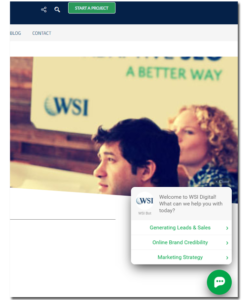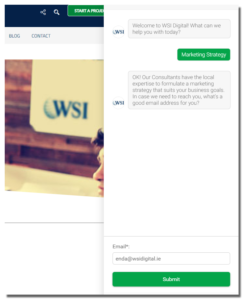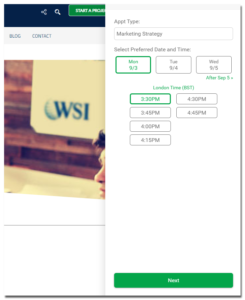Customer expectation from brands is at an all time high and as a result customers are demanding immediate attention when they look for help.
As marketers, we have to take some responsibility for the hoops that we make our customers jump through.
We have become obsessed in pushing prospects down this imaginary funnel and recording mini successes when the person takes an action that we want them to. The reality though is that no two customer journeys are exactly the same.

According to Google:
Digital technology and mobile devices have put people in control. We all now expect an immediate answer in the moments we want to know, go, do, and buy.
And all of these intent-rich moments are creating journey shapes as unique as each of us. In many ways, intent is redefining the marketing funnel. – Google
The form fill is a classic example of this.
When it comes to digital marketing, we love when website visitors complete our forms.
It lets us know that the visitor was interested enough in our marketing messages to take action, we now have contact information from the prospect, we can add them to our CRM database and in many cases – GDPR police, please stop reading 😉 – we can now market directly to them with our email campaigns.
Big whoops all round.
So what does this look like for the customer?
They go to your website, fill out a form and are promised that your sales team will get back to them later. When is later? Will a sales guy keep calling them? Will they be interrupted while they are at work?
The reality is that suddenly the customer is no longer in control and they have no idea whats going to happen next. And that’s not a great customer experience…
So enter the chatbot.
According to a 2017 report conducted by Ubisend, 69% of consumers would use a chatbot before engaging with a human, as consumers would prefer to receive an immediate answer.
For those of you new to the concept, a chatbot is an artificial intelligence (AI) program, typically residing on your website, that simulates interactive human conversation by serving up pre-configured answers to typical questions that are asked by your audience.
There is no doubting the rise in popularity of Chatbots. As well as being a lifesaver for heavy volume campaigns where you can expect a big response in terms of enquiries, Chatbots are also useful for low volume campaigns where the few site visitors that arrive at your page need to be responded to promptly. A correctly configured chatbot can save time and effort from community managers as well as providing a fast response to visitors who without a quick response may end up going to one of your competitors.
When we think about chatbots, we usually think about technology and the advanced automation engines that support and drive the chatbot options. While this may be the case, it’s up to marketers and sales managers to explore several traditional marketing aspects before they engage in the programming and configuring of their site’s chatbot.

A chatbot is only a means of automating something that would otherwise be done by humans, and this automatization means that you need to think deeply about customer journeys and the CX (customer Experience) along that path. A chatbot drives the visitor through a carefully crafted journey and to make that journey successful, a deep understanding of the target market is needed. As it happens with many of the digital strategies, it all starts with persona analysis.
In a previous blog post where we spoke about using marketing automation tactics to tackle GDPR challenges, we looked at personas and how important they are to consider when setting up any automation within your marketing campaigns. For Chatbot configuration, the aspects of your personas will define the different journeys through which a visitor can be taken. Therefore, you should pay careful attention to the questions or options that a chatbot will present to a visitor to detect their persona, the path they should be directed to, and the steps that comprise each of those paths.
And here’s where things get traditional; once you have your personas, the best way to define the path and the steps along each journey is to talk to salespeople, customer representatives, inside sales agents, customer support agents, and community managers. A session with them will help you map the questions and enquiries that each persona wants to have answered or solved and such a map will be the foundation of a chatbot programming.
Each step that a human representative would have taken with a visitor needs to be translated into an automated action that can be reproduced so the chatbot can behave like a human representative. The more options you provide and the more detailed the journey is programmed, the better the experience for the visitor.
Using our own website’s Chatbot as an example: Many business executives come to our company page in order to speak to a consultant about their digital marketing but more often than not need guidance in the correct strategy to take. This is why, the initial options on our Chatbot are based on broad reaching goals, so we can effectively direct the visitor down the path which will suit them the best in terms of how we can help them.
Firstly, the visitor is greeted with the Chatbot options.

Then, after choosing their marketing goal, we collect some customer details.

This leads to the customer booking a call with us, automatically.

A good chatbot implementation will result in an action performed by the visitor. The visitor will feel promptly served, and your company will have better results and a cost-effective operation that can operate for many customers at once.
The best way to begin the structure of your Chatbot is to create a diagram, showing the flow each possible conversation will take. The process becomes more complex as special conditions start to be combined. If visitor A that fit persona X, answered “yes” to the first question, but then answered “no” to the third question, then they could be directed to an information page or asked to set up a call via the automated calendar. Of course, these Chatbots have alerts built into them to tell your sales or support team that there is a customer starting a conversation making it very easy to hop unto the chat yourself if you have the time.
There really are limitless possibilities to Chatbots but the customization does not end with the script. Many solutions will have the option for advanced triggering. This allows your Chatbot to only appear under certain conditions such as; specific pages or even new or returning visitors.
How you build your Chatbot’s path structure will greatly depend on your company’s goals but what is certain is that most website using this technology, will ensure a better customer experience for their visitors. Automated Chatbots require us all to think as marketers and do our homework understanding our visitor, and then requires the necessary technical skills to transform that knowledge into programmed and automated actions that can drive the conversation, leading to new contacts for your business.
As is often the case with implementing new technologies, the tech element is the easy piece, the challenge is usually around the use case and how best to integrate it into your company’s goals.
This article was inspired by my colleague Carlos Guzman. Carlos has been a member of the WSI community since 2004, he leads a digital marketing agency ranked #20 for Mexico and servicing Mexican and Latam customers. Their specialty is in social listening and analytics-based digital strategies.

Stay Connected